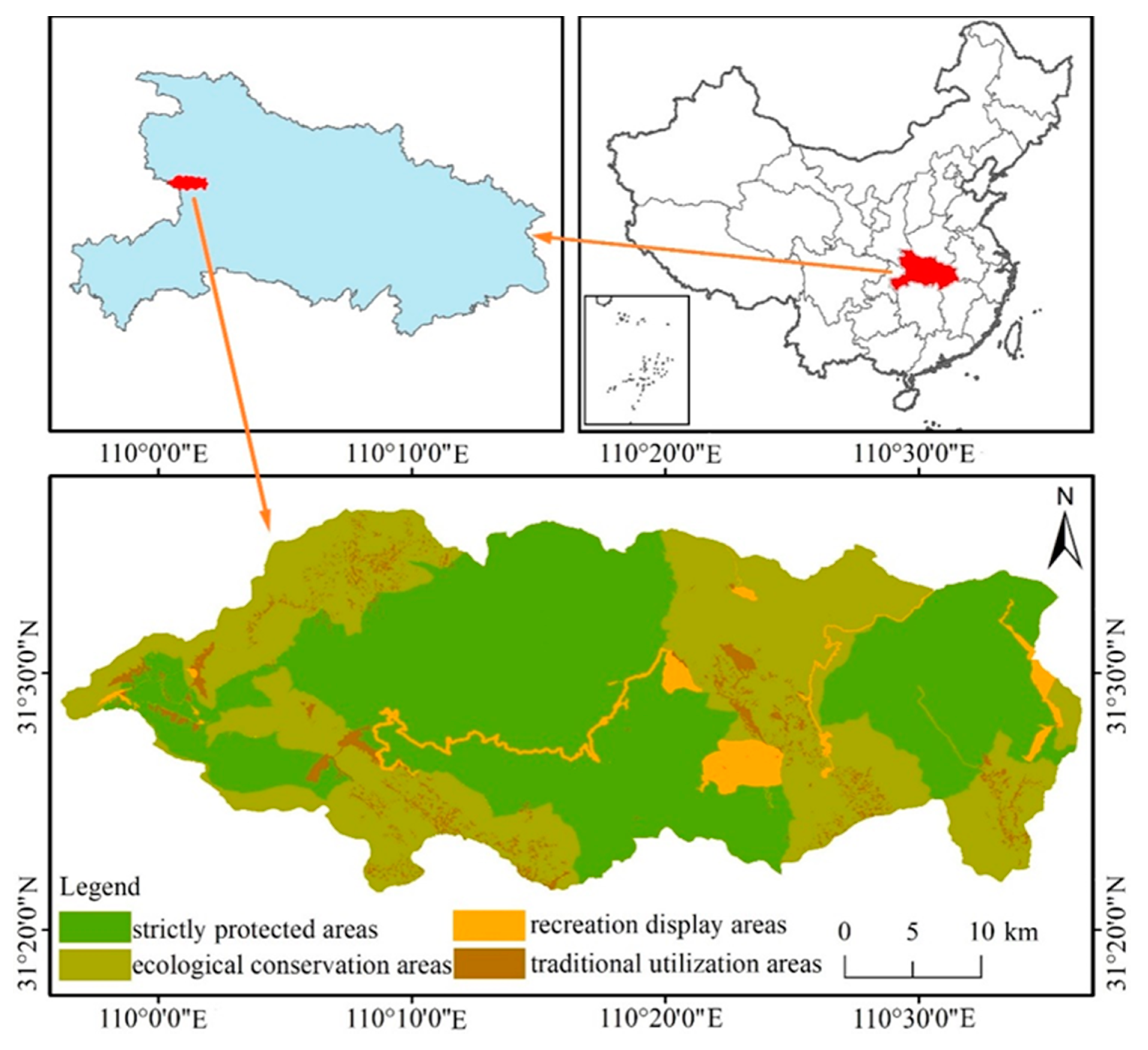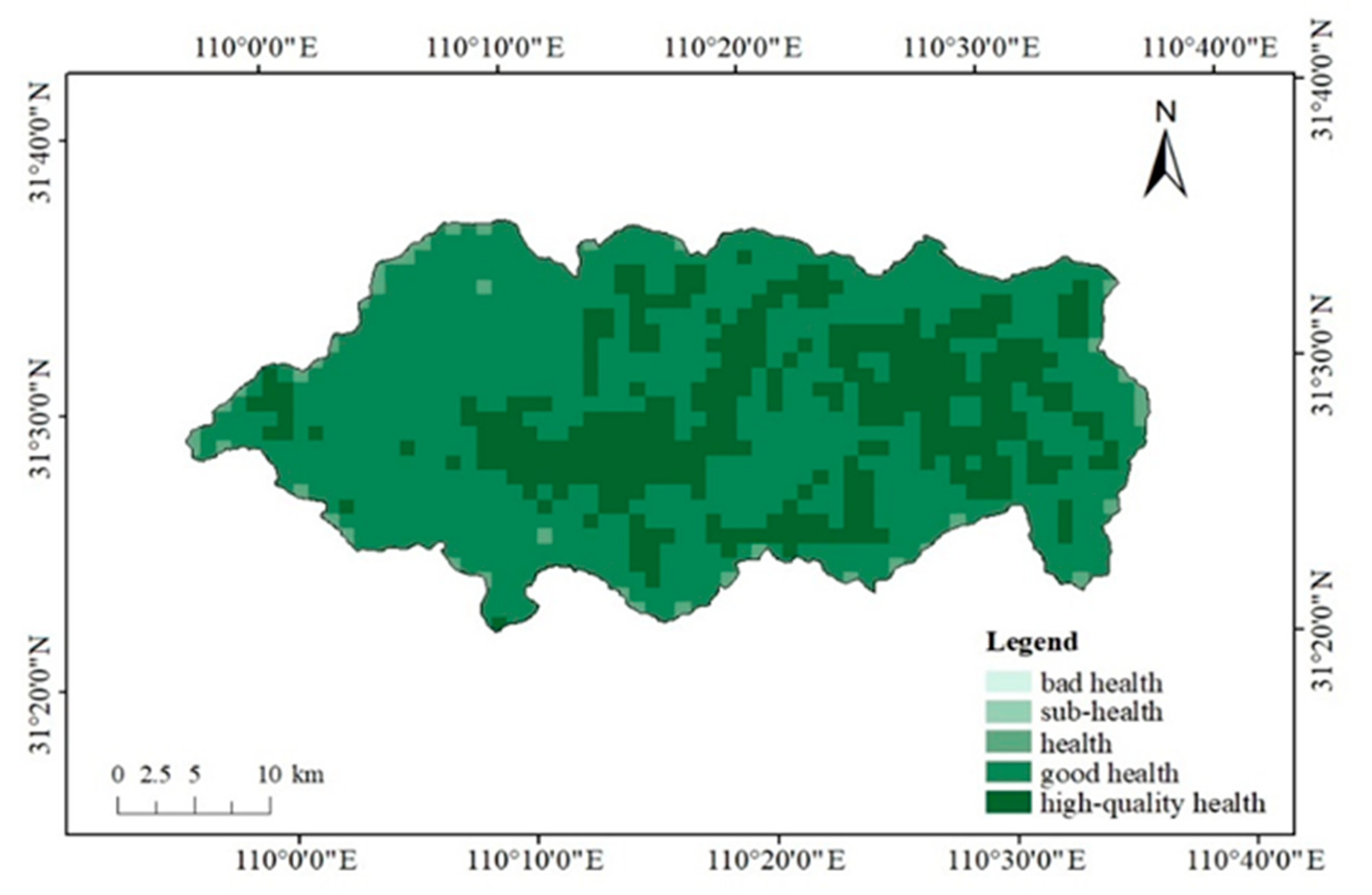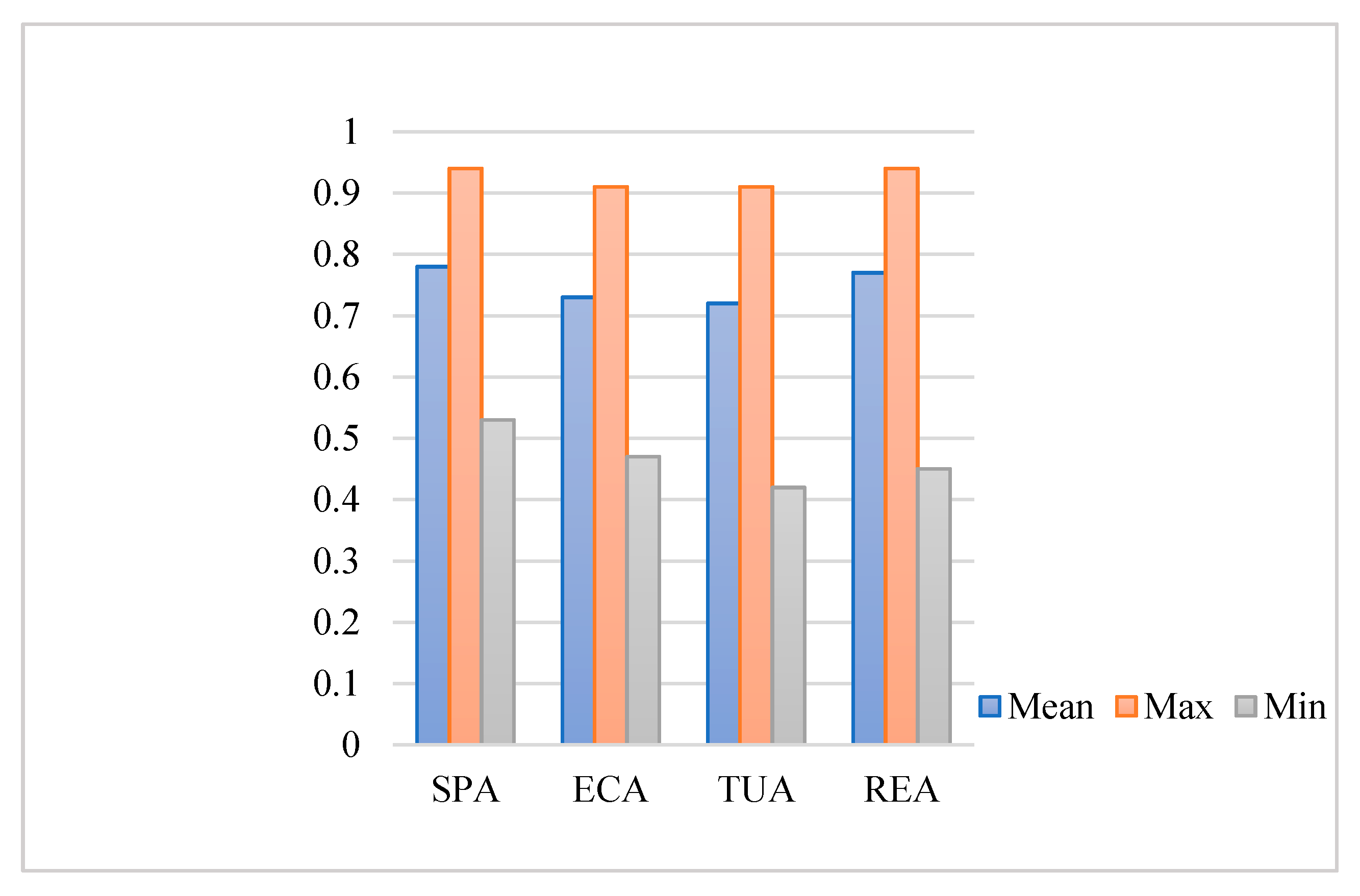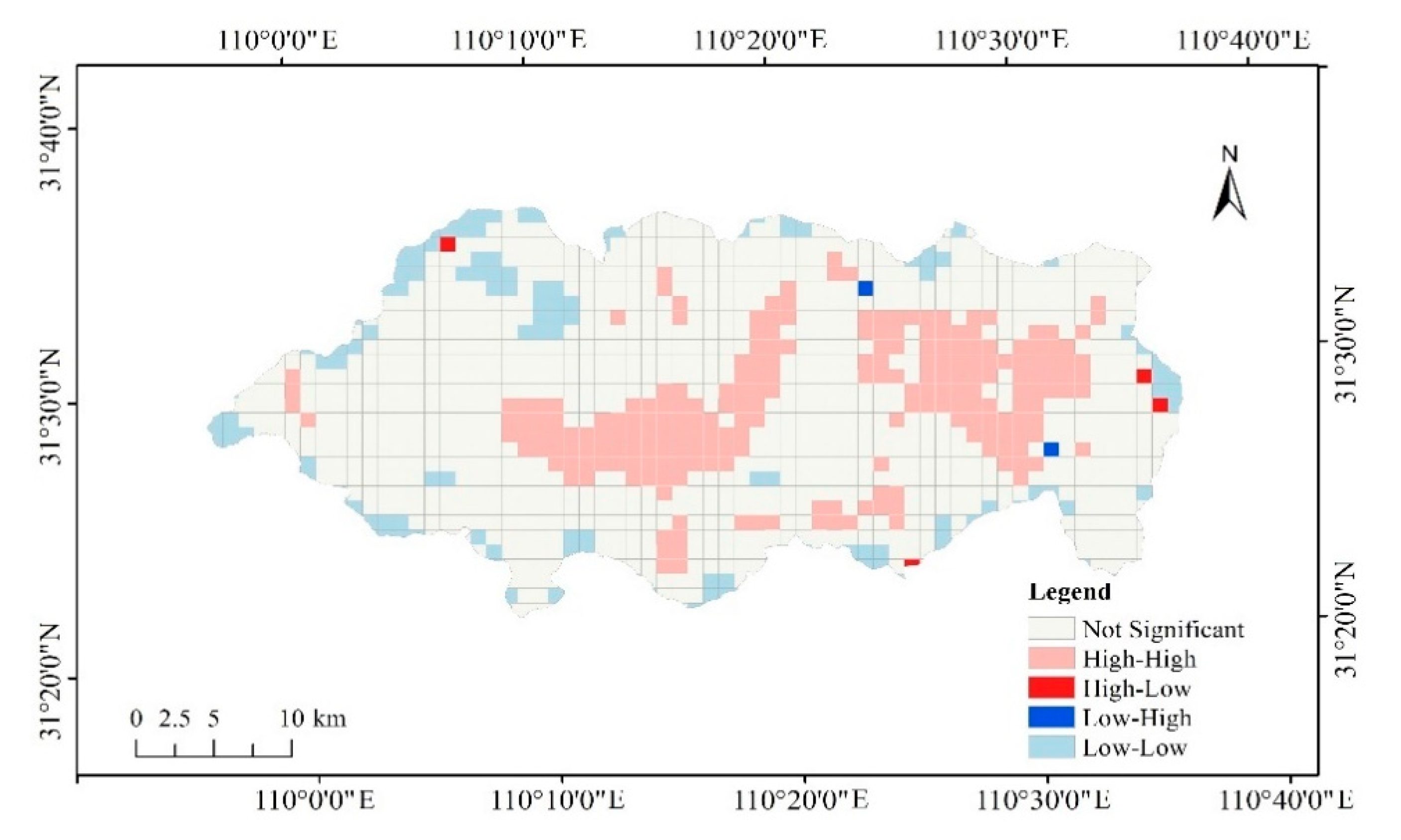Ecological Health Assessment of Chinese National Parks Based on Landscape Pattern: A Case Study in Shennongjia National Park
Abstract
:1. Introduction
2. Materials and Methods
2.1. Study Area
2.2. Data Collection and Analysis
2.2.1. Spatial Data Pre-Processing and Classification of Landscape Types
2.2.2. Selection of Landscape Pattern Indexes
2.2.3. Selection of Grid Size and Landscape Pattern Indexes
2.2.4. The Normalization of Evaluation Indicators and the Establishment of Indicator Weights
2.2.5. Ecosystem Health Assessment Method and Assessment Grade Determination
2.2.6. Spatial Autocorrelation Analysis
3. Results
3.1. Landscape Pattern Characteristics of Class Level
3.2. Landscape Pattern Characteristics of Landscape Level
3.3. Comprehensive Assessment of Ecosystem Health in Shennongjia National Park
3.4. Spatial Pattern Characteristics of Ecosystem Health in Shennongjia National Park
4. Discussion
4.1. Relationship between Landscape Pattern and Ecosystem Health
4.2. Analysis of Ecosystem Health Status
4.3. Implications for Ecological Conservation in Chinese National Park
4.4. Limitations and Future Research Directions
5. Conclusions
Author Contributions
Funding
Institutional Review Board Statement
Informed Consent Statement
Acknowledgments
Conflicts of Interest
References
- Daily, G.C.; Alexander, S.; Ehrlich, P.R.; Goulder, L.; Tilman, D. Ecosystem services: Benefits supplied to human societies by natural ecosystems. Issues Ecol. 1997, 1, 1–16. [Google Scholar]
- Wang, H.; Zhou, S.; Li, X.; Liu, H.; Chi, D.; Xu, K. The influence of climate change and human activities on ecosystem service value. Ecol. Eng. 2016, 87, 224–239. [Google Scholar] [CrossRef]
- Xu, W.H.; Xiao, Y.; Zhang, J.J.; Yang, W.; Zhang, L.; Hullc, V.; Wang, Z.; Zheng, H.; Liu, J.G.; Liu, J.G.; et al. Strengthening protected areas for biodiversity and ecosystem services in China. Proc. Natl. Acad. Sci. USA 2017, 114, 1601–1606. [Google Scholar] [CrossRef] [Green Version]
- Mallarach, J.M.; Verschuuren, B. Changing Concepts and Values in Natural Heritage Conservation: A View through IUCN and UNESCO Policies; The Getty Conservation Institute Press: Los Angeles, CA, USA, 2019; pp. 141–157. ISBN 978-16-0606-618-8. [Google Scholar]
- Urbis, A.; Ramūnas, P.; Imanauskien, R.; Taminskas, J. Key aesthetic appeal concepts of coastal dunes and forests on the example of the Curonian Spit (Lithuania). Water 2019, 11, 1193. [Google Scholar] [CrossRef] [Green Version]
- Ouyang, Z.Y. Development and status of forestry nature reserves in China. For. Sci. Technol. 2002, 4, 71–78. [Google Scholar]
- Du, A.; Cui, T.; Ouyang, Z.Y. International experiences of national park selection criteria and the inspiration to China. Acta Geogr. Sin. 2020, 40, 7231–7237. [Google Scholar]
- He, S.Y.; Su, Y.; Wang, L.; Louise, G.; Cheng, H.G. Taking an ecosystem services approach for a new national park system in China. Resour. Conserv. Recycl. 2018, 137, 136–144. [Google Scholar] [CrossRef]
- Wang, J. National parks in China: Parks for people or for the nation? Land Use Policy 2019, 81, 825–833. [Google Scholar] [CrossRef]
- Du, A.; Xu, W.; Xiao, Y.; Cui, T.; Ouyang, Z.Y. Evaluation of prioritized natural landscape conservation areas for national park planning in China. Sustainability 2020, 12, 1840. [Google Scholar] [CrossRef] [Green Version]
- Wang, H.; Hou, P.; Jiang, J.B.; Xiao, R.L.; Zhai, J.; Fu, Z.; Hou, J. Ecosystem Health Assessment of Shennongjia National Park, China. Sustainability 2020, 12, 7672. [Google Scholar] [CrossRef]
- Peng, J.; Liu, Y.X.; Wu, J.S.; Lv, H.L.; Hu, X.X. Linking ecosystem services and landscape patterns to assess urban ecosystem health: A case study in Shenzhen City, China. Landsc. Urban Plan. 2015, 143, 56–68. [Google Scholar] [CrossRef]
- Rapport, D.J. What constitutes ecosystem health? Perspect. Biol. Med. 1989, 33, 120–132. [Google Scholar] [CrossRef]
- Halpern, B.S.; Longo, C.; Hardy, D.; McLeod, K.L.; Samhouri, J.F.; Katona, S.K.; Kleisner, K.; Lester, S.E.; O’Leary, J.; Ranelletti, M.; et al. An index to assess the health and benefits of the global ocean. Nature 2012, 488, 615–620. [Google Scholar] [CrossRef] [Green Version]
- Shi, Y.; Han, R.; Guo, L. Temporal–spatial distribution of ecosystem health and its response to human interference based on different terrain gradients: A case study in Gannan, China. Sustainability 2020, 12, 1773. [Google Scholar] [CrossRef] [Green Version]
- Zhu, G.; Noman, M.A.; Narale, D.D.; Feng, W.; Sun, J. Evaluation of ecosystem health and potential human health hazards in the Hangzhou Bay and Qiantang Estuary region through multiple assessment approaches. Environ. Pollut. 2020, 264, 114791. [Google Scholar] [CrossRef]
- Wang, Z.; Yang, Z.; Shi, H.; Han, F.; Liu, Y. Ecosystem health assessment of world natural heritage sites based on remote sensing and field sampling verification: Bayanbulak as case study. Sustainability 2020, 12, 2610. [Google Scholar] [CrossRef] [Green Version]
- Kim, Y.O.; Xu, F.L. Marine ecosystem health assessments in Korean coastal water body. Ocean Sci. J. 2014, 49, 249–250. [Google Scholar] [CrossRef] [Green Version]
- Pinto, U.; Maheshwari, B.L. River health assessment in peri-urban landscapes: An application of multivariate analysis to identify the key variables. Water Res. 2011, 45, 3915–3924. [Google Scholar] [CrossRef] [PubMed]
- Wang, X.B.; Liu, W.N.; Wu, W.L. A holistic approach to the development of sustainable agriculture: Application of the ecosystem health model. Int. J. Sustain. Dev. World Ecol. 2009, 16, 339–345. [Google Scholar] [CrossRef]
- Xiao, F.J.; Ouyang, H.; Fu, B.J.; Niu, H.S. Forest ecosystem health assessment indicators and application in China. Acta Geogr. Sin. 2003, 160, 805–809. [Google Scholar]
- Pelletier, M.C.; Gold, R.J.; Heltshe, R.F.; Buffum, R.W. A method to identify estuarine macroinvertebrate pollution indicator species in the Virginian Biogeographic Province. Ecol. Indic. 2010, 10, 1037–1048. [Google Scholar] [CrossRef]
- Kong, H.M.; Zhao, J.Z.; Ma, K.M.; Zhang, P.; Ji, L.Z.; Deng, H.B.; Lu, Z.H. Preliminary study on the evaluation method of ecosystem health. J. Appl. Ecol. 2002, 4, 486–490. [Google Scholar]
- Cairns, J.; McCormick, P.V.; Niederlehner, B.R. A proposed framework for developing indicators of ecosystem health. Hydrobiologia 1992, 263, 1–44. [Google Scholar] [CrossRef]
- Patil, G.P.; Brooks, R.P.; Myers, W.L.; Rapport, D.J.; Taillie, C. Ecosystem health and its measurement at landscape scale: Toward the next generation of quantitative assessments. Ecosyst. Health 2010, 7, 307–316. [Google Scholar] [CrossRef]
- Das, S.; Pradhan, B.; Shit, P.K.; Alamri, A.M. Assessment of wetland ecosystem health using the pressure–state–response (PSR) model: A case study of mursidabad district of West Bengal (India). Sustainability 2020, 12, 5932. [Google Scholar] [CrossRef]
- Wu, R.D.; Hua, C.L.; Yu, G.Z.; Ma, J.Z.; Yang, F.L.; Wang, J.J.; Jin, T.; Long, Y.C.; Guo, Y.; Zhao, H.W. Assessing protected area overlaps and performance to attain China’s new national park system. Biol. Conserv. 2020, 241, 108382. [Google Scholar] [CrossRef]
- Backhaus, R.; Bock, M.; Weiers, S. The spatial dimension of landscape sustainability. Environ. Dev. Sustain. 2002, 4, 237–251. [Google Scholar] [CrossRef]
- Zhang, Y.; Zhou, Y.Y.; Liu, X.F.; Yu, H.L.; Li, D.Q.; Zhang, Y.G. Genetic diversity of the sichuan snub-nosed monkey (rhinopithecus roxellana) in shennongjia national park, china using rad-seq analyses. Genetica 2019, 147, 327–335. [Google Scholar] [CrossRef]
- Xie, D.; Wang, Y.Q.; Zhang, X.S.; Wu, Y.; Yang, J.Y.; Zhang, D.G. A catalogue of plant type specimens and history of plant collecting in Shennongjia National Park. Biodivers. Sci. 2019, 27, 211–218. [Google Scholar]
- Pan, S.L.; Wang, X.Q.; Mao, Y.; Wang, K.; Yu, Y. An analysis of the awareness and attitudes of community residents and visitors to national parks—Taking Shennongjia National Park as an example. Environ. Prot. 2019, 47, 65–69. [Google Scholar]
- Chen, Y.; Guo, Y.; Liu, Y.; Chen, X.G.; Shao, C.Y. Detection and analysis of land cover changes in Shennongjia National Park from 1990 to 2016. For. Sci. Technol. News 2018, 1, 19–23. [Google Scholar]
- Hubei Daily. Regulations on the Protection of Shennongjia National Park. Hubei Daily, 30 November 2017; 10. [Google Scholar]
- Turner, M.G.; Gardner, R.H. Landscape Ecology in Theory and Practice: Pattern and Process; Springer: New York, NY, USA, 2015; pp. 97–142. ISBN 978-1-4939-2794-4. [Google Scholar]
- McGarigal, K.; Cushman, S.A.; Ene, E. FRAGSTATS v4: Spatial Pattern Analysis Program for Categorical Maps. Computer Software Program Produced by the Authors at the University of Massachusetts, Amherst, MA, USA. 2012. Available online: www.umass.edu/landeco/research/fragstats/fragstats.html (accessed on 1 June 2012).
- Rapport, D.J.; Costanza, R.; Mcmichael, A.J. Assessing ecosystem health. Trends Ecol. Evol. 1998, 10, 397–402. [Google Scholar] [CrossRef]
- Hou, W.; Gao, J.; Wu, S. Interannual variations in growing-season NDVI and its correlation with climate variables in the southwestern Karst region of China. Remote Sens. 2015, 7, 11105–11124. [Google Scholar] [CrossRef] [Green Version]
- Liu, D.; Hao, S. Ecosystem health assessment at county-scale using the pressure-state-response framework on the Loess Plateau, China. Int. J. Environ. Res. Public Health 2017, 14, 2. [Google Scholar] [CrossRef] [PubMed] [Green Version]
- Fan, L.; Li, Z. A model of ecosystem health and its application. Ecol. Model. 2003, 170, 55–59. [Google Scholar]
- Xiao, Y.; Guo, L.; Sang, W.G. Impact of fast urbanization on ecosystem health in mountainous regions of southwest China. Int. J. Environ. Res. Public Health 2020, 17, 826. [Google Scholar] [CrossRef] [Green Version]
- Turner, M.G. Landscape ecology: The effect of pattern on process. Annu. Rev. Ecol. Syst. 1989, 20, 171–197. [Google Scholar] [CrossRef]
- Suo, A.; Xiong, Y.; Wang, T.; Yue, D.; Ge, J. Ecosystem health assessment of the Jinghe River watershed on the Huangtu Plateau. EcoHealth 2008, 5, 127–136. [Google Scholar] [CrossRef]
- Peng, J.; Liu, Y.; Li, T.; Wu, J. Regional ecosystem health response to rural land use change: A case study in Lijiang City, China. Ecol. Indic. 2017, 72, 399–410. [Google Scholar] [CrossRef]
- Xie, G.D.; Zhen, L.; Lu, C.X.; Xiao, Y.; Chen, C. Expert knowledge based valuation method of ecosystem services in China. J. Nat. Resour. 2008, 23, 911–919. [Google Scholar]
- Richardson, A.D.; Keenan, T.F.; Migliavacca, M.; Ryu, Y.; Sonnentag, O.; Toomey, M. Climate change, phenology, and phenological control of vegetation feedbacks to the climate system. Agric. For. Meteorol. 2013, 169, 156–173. [Google Scholar] [CrossRef]
- Sun, B.D.; Tang, J.C.; Yu, D.; Song, Z.W.; Wang, P.G. Ecosystem health assessment: A PSR analysis combining AHP and FCE methods for Jiaozhou Bay, China. Ocean Coast. Manag. 2019, 168, 41–50. [Google Scholar] [CrossRef]
- Cheng, X.; Chen, L.D.; Sun, R.H.; Kong, P.R. Land use changes and socio-economic development strongly deteriorate river ecosystem health in one of the largest basins in China. Sci. Total Environ. 2018, 616–617, 376–385. [Google Scholar] [CrossRef]
- Moran, P.A.P. Notes on continuous stochastic phenomena. Biometrika 1950, 37, 17–23. [Google Scholar] [CrossRef] [PubMed]
- Anselin, L. Local indicators of spatial association—LISA. Geogr. Anal. 1995, 27, 93–115. [Google Scholar] [CrossRef]
- Teng, M.J.; Zeng, L.X.; Zhou, Z.X.; Wang, P.C.; Xiao, W.F. Responses of landscape metrics to altering grain size in the Three Gorges Reservoir landscape in China. Environ Earth Sci. 2016, 75, 1055. [Google Scholar] [CrossRef]
- Meng, W.A.; Li, S. Analysis on the construction path of Shennongjia National Park System Pilot Area. Int. J. Geoheritage Parks 2020, 8, 235–238. [Google Scholar]
- Wang, Z.Z.; Mao, X.Q.; Zeng, W.H.; Xie, Y.X.; Ma, B.R. Exploring the influencing paths of natives’ conservation behavior and policy incentives in protected areas: Evidence from China. Sci. Total Environ. 2020, 744, 140728. [Google Scholar] [CrossRef]
- Frondoni, R.; Mollo, B.; Capotorti, G. A landscape analysis of land cover change in the Municipality of Rome (Italy): Spatio-temporal characteristics and ecological implications of land cover transitions from 1954 to 2001. Landsc. Urban Plan. 2011, 100, 117–128. [Google Scholar] [CrossRef]
- Su, M.; Fath, B.D.; Yang, Z. Urban ecosystem health assessment: A review. Sci. Total Environ. 2010, 408, 2425–2434. [Google Scholar] [CrossRef]
- Shen, W.; Zheng, Z.; Qin, Y.; Li, Y. Spatiotemporal characteristics and driving force of ecosystem health in an important ecological function region in China. Int. J. Environ. Res. Public Health 2020, 17, 5075. [Google Scholar] [CrossRef] [PubMed]
- Rapport, D.J. Ecosystem services and management options as blanket indicators of ecosystem health. J. Aquat. Ecosyste Health 1995, 4, 97–105. [Google Scholar] [CrossRef]
- Kang, P.; Chen, W.; Hou, Y.; Li, Y. Linking ecosystem services and ecosystem health to ecological risk assessment: A case study of the Beijing-Tianjin-Hebei urban agglomeration. Sci. Total Environ. 2018, 636, 1442–1454. [Google Scholar] [CrossRef] [PubMed]
- He, J.H.; Pan, Z.Z.; Liu, D.F.; Guo, X.N. Exploring the regional differences of ecosystem health and its driving factors in China. Sci. Total Environ. 2019, 673, 553–564. [Google Scholar] [CrossRef] [PubMed]




| Date | Path | Row | Cloudcover | Sunelevation | Sunazimuth |
|---|---|---|---|---|---|
| 2019/11/03 | 125 | 38 | 2.87 | 40.36029328 | 157.45013021 |
| 2019/11/10 | 126 | 38 | 5.44 | 38.36455604 | 158.26941673 |
| Index | Ecological Significance |
|---|---|
| CA (Total class area) | The CA is the sum of the areas of all the patches in a landscape type. |
| PLAND (Percentage of landscape) | The PLAND is the total area of a landscape type as a percentage of the total area of the study area. |
| LPI (Largest patch index) | The LPI is the proportion of the largest patch in a landscape type to the total area of the study area. |
| NP (Number of patches) | The NP index refers to the total number of patches of a certain landscape type and is usually used to describe the heterogeneity of the entire landscape. |
| PD (Patch density) | The PD index is an important indicator reflecting the degree of fragmentation and dispersion of the landscape. |
| LSI (Landscape shape index) | The LSI is an index which can reflect the characteristics of the patch shape. |
| COHESION (Patch Cohesion Index) | The COHESION index reflects the degree of natural connectivity of related landscape types. |
| CONTAG (Contagion Index) | The CONTAG describes the degree of agglomeration or spreading trend of different patch types in the landscape. |
| IJI (Interspersion Juxtaposition Index) | The IJI can reflect the overall interspersion and juxtaposition of various patch types at the landscape level. |
| SHEI (Shannon’s Evenness Index) | The SHEI is an indicator reflecting the dominant patches and their distribution status in the landscape. |
| SHDI (Simpson’s Diversity Index) | The SHDI index is sensitive to the uneven distribution of various patch types in the landscape, and it emphasizes the contribution of rare patch types. |
| Objective Layer | Principle Layer | Quota Layer |
|---|---|---|
| Ecological health assessment of National Park | Vigor | Vegetation Cover Index |
| Organization | COHESION (Patch Cohesion Index) | |
| CONTAG (Contagion Index) | ||
| IJI (Interspersion Juxtaposition Index) | ||
| SHDI (Shannon’s Diversity Index) | ||
| SHEI (Shannon’s Evenness Index) | ||
| PR (Patch Richness) | ||
| Resilience | SIDI (Simpson’s Diversity Index) | |
| Resilience Index |
| Ecosystem Type | Forest Land | Grassland | Construction Land | Farmland | Water Body | Bare Land |
|---|---|---|---|---|---|---|
| Resilience coefficient | 0.9 | 0.8 | 0.2 | 0.5 | 0.8 | 0.2 |
| Landscape Types | CA (ha) | PLAND (%) | LPI (%) | NP (no.) | PD (no./100 ha) | LSI |
|---|---|---|---|---|---|---|
| Coniferous forest | 15,094.08 | 12.9579 | 5.2406 | 18 | 0.0155 | 8.5720 |
| Deciduous broadleaf forest | 51,441.59 | 43.9896 | 22.1622 | 49 | 0.0421 | 13.394 |
| Evergreen broadleaf forest | 5113.26 | 4.3896 | 1.1755 | 25 | 0.0215 | 8.6478 |
| Mixed coniferous broadleaf forest | 12,047.49 | 10.3425 | 1.4362 | 25 | 0.0215 | 8.0369 |
| Shrubs | 19,802.61 | 17.0000 | 5.9547 | 26 | 0.0223 | 10.2151 |
| Grassland | 2692.98 | 2.3119 | 0.3527 | 51 | 0.0438 | 10.9682 |
| Farmland | 475.83 | 0.4085 | 0.1080 | 525 | 0.4507 | 20.5479 |
| Water body | 166.41 | 0.1429 | 0.0677 | 25 | 0.0215 | 6.9302 |
| Construction land | 9851.22 | 8.4570 | 2.6256 | 676 | 0.5803 | 17.9154 |
| Bare land | 0.18 | 0.0002 | 0.0002 | 1 | 0.0009 | 1.0000 |
| COHESION | CONTAG | IJI | SHEI | SHDI |
|---|---|---|---|---|
| 99.5035 | 61.5169 | 73.0325 | 0.7066 | 1.6270 |
| Evaluation Criteria | Evaluation Index | Weight | Standardized Indicator Value | Comprehensive Assessment Value |
|---|---|---|---|---|
| Vigor (0.279) | Vegetation Cover Index | 0.297 | 0.989 | 0.74 |
| Organization (0.541) | COHESION (Patch Cohesion Index) | 0.116 | 0.896 | |
| CONTAG (Contagion Index) | 0.116 | 0.497 | ||
| IJI (Interspersion Juxtaposition Index) | 0.039 | 0.407 | ||
| SHDI (Shannon’s Diversity Index) | 0.070 | 0.399 | ||
| SHEI (Shannon’s Evenness Index) | 0.028 | 0.463 | ||
| PR (Patch Richness) | 0.172 | 0.526 | ||
| Resilience (0.163) | SIDI (Simpson’s Diversity Index) | 0.027 | 0.458 | |
| Resilience Index | 0.136 | 0.937 |
Publisher’s Note: MDPI stays neutral with regard to jurisdictional claims in published maps and institutional affiliations. |
© 2021 by the authors. Licensee MDPI, Basel, Switzerland. This article is an open access article distributed under the terms and conditions of the Creative Commons Attribution (CC BY) license (https://creativecommons.org/licenses/by/4.0/).
Share and Cite
Shu, H.; Xiao, C.; Ma, T.; Sang, W. Ecological Health Assessment of Chinese National Parks Based on Landscape Pattern: A Case Study in Shennongjia National Park. Int. J. Environ. Res. Public Health 2021, 18, 11487. https://doi.org/10.3390/ijerph182111487
Shu H, Xiao C, Ma T, Sang W. Ecological Health Assessment of Chinese National Parks Based on Landscape Pattern: A Case Study in Shennongjia National Park. International Journal of Environmental Research and Public Health. 2021; 18(21):11487. https://doi.org/10.3390/ijerph182111487
Chicago/Turabian StyleShu, Hang, Chunwang Xiao, Ting Ma, and Weiguo Sang. 2021. "Ecological Health Assessment of Chinese National Parks Based on Landscape Pattern: A Case Study in Shennongjia National Park" International Journal of Environmental Research and Public Health 18, no. 21: 11487. https://doi.org/10.3390/ijerph182111487
APA StyleShu, H., Xiao, C., Ma, T., & Sang, W. (2021). Ecological Health Assessment of Chinese National Parks Based on Landscape Pattern: A Case Study in Shennongjia National Park. International Journal of Environmental Research and Public Health, 18(21), 11487. https://doi.org/10.3390/ijerph182111487








